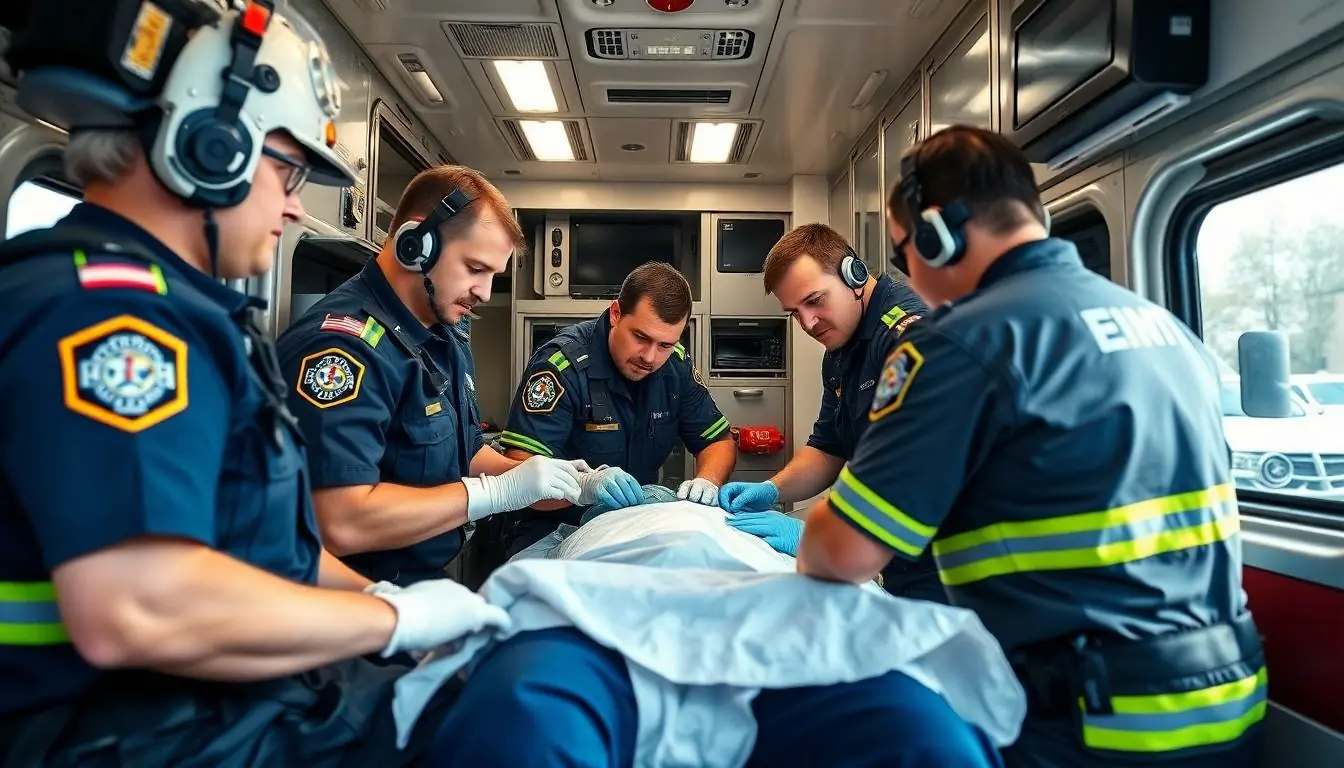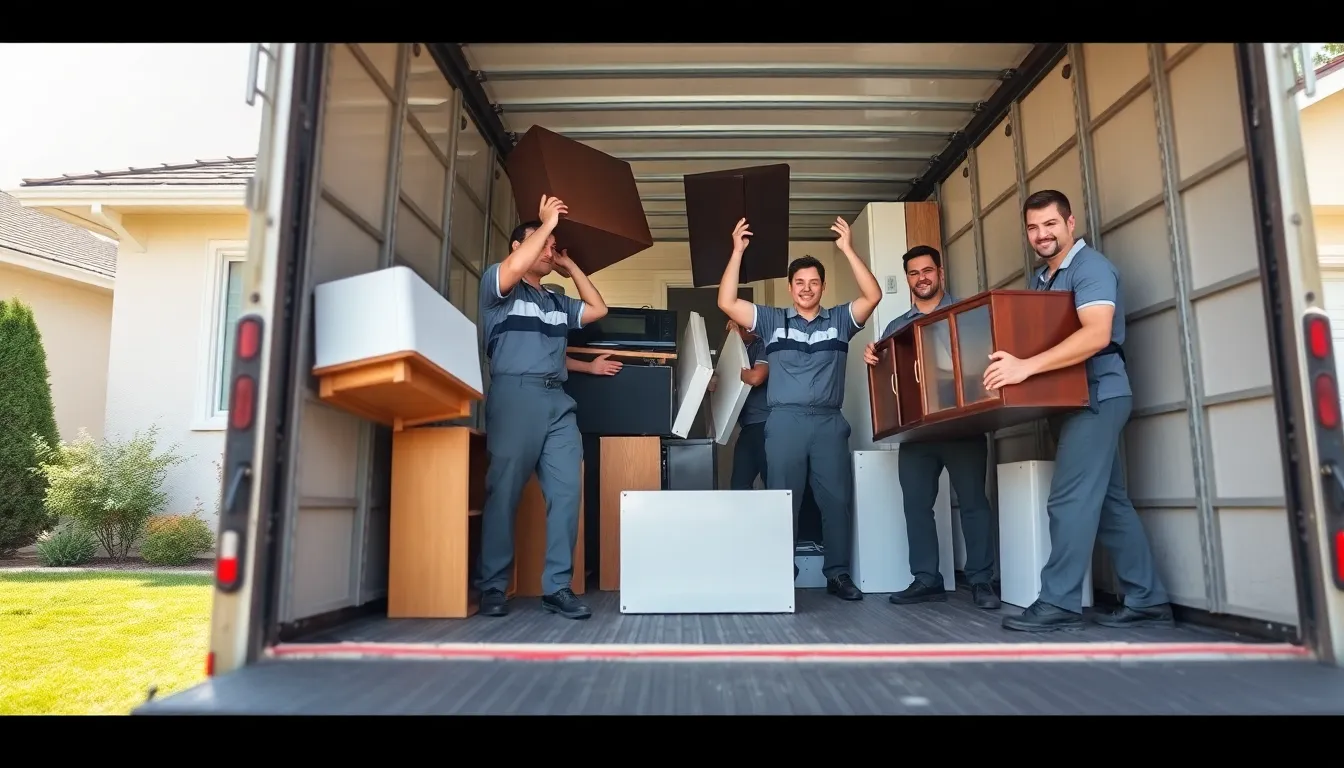When seconds count and lives hang in the balance, prehospital emergency care becomes the crucial link between crisis and survival. These dedicated first responders serve as the frontline heroes who bring emergency medical expertise directly to patients before they reach the hospital.
From heart attacks in suburban homes to car accidents on busy highways, emergency medical technicians (EMTs) and paramedics face unpredictable challenges daily. They’re the medical superheroes without capes who transform ambulances into mobile emergency rooms, delivering life-saving interventions at a moment’s notice. Advanced equipment, quick thinking and years of specialized training come together in a perfectly orchestrated dance to provide care when it matters most.
Table of Contents
ToggleWhat Is Prehospital Emergency Care
Prehospital emergency care encompasses all medical services provided to patients before they arrive at a hospital. Emergency Medical Services (EMS) professionals deliver immediate medical interventions at the scene of emergencies through transportation to definitive care facilities.
Key components of prehospital care include:
- Basic life support measures like CPR airway management
- Advanced cardiac monitoring procedures
- Trauma stabilization techniques
- Emergency medication administration
- Patient transport coordination
The primary care providers in prehospital settings are:
| Provider Level | Training Hours | Scope of Care |
|---|---|---|
| EMT-Basic | 120-150 | Basic life support |
| EMT-Advanced | 175-250 | Limited advanced procedures |
| Paramedic | 1,200-1,800 | Advanced life support |
These medical professionals operate in diverse environments:
- Urban emergency response units
- Rural ambulance services
- Air medical transport teams
- Special operations units
- Mass casualty incident teams
Prehospital care involves a systematic approach:
- Initial scene assessment for safety
- Primary patient evaluation
- Vital sign monitoring
- Treatment administration
- Transport decisions
- Hospital communication
Modern prehospital care integrates advanced medical equipment:
- Automated external defibrillators
- Mobile cardiac monitors
- Advanced airway devices
- Emergency medications
- Patient tracking systems
- Communication technology
This organized system connects emergency responders dispatch centers hospitals to create a seamless chain of survival for patients experiencing medical emergencies.
Components of Emergency Medical Services
Emergency Medical Services integrate personnel, equipment, and transportation systems to deliver lifesaving care. These interconnected elements form a comprehensive network of emergency response capabilities.
First Responders and EMTs
Emergency Medical Technicians operate at three certification levels: EMT-Basic, EMT-Advanced, and Paramedic. EMT-Basics perform essential life support procedures like CPR, wound care, and patient stabilization. Advanced EMTs administer intravenous fluids, specific medications, and advanced airway interventions. Paramedics deliver complex medical procedures including cardiac monitoring, emergency medication administration, and advanced trauma care. Supporting these professionals, firefighters and police officers serve as certified first responders, providing immediate basic life support until EMTs arrive.
Emergency Medical Equipment
Modern EMS systems utilize specialized equipment for patient assessment and treatment. Cardiac monitors track vital signs and transmit data to receiving hospitals. Automated External Defibrillators restore normal heart rhythms during cardiac emergencies. Portable ventilators support patients with breathing difficulties. Advanced airway management devices include laryngoscopes and intubation equipment. Trauma care supplies feature splints, cervical collars, and hemorrhage control materials. Communication devices connect EMTs with medical control centers and receiving facilities.
Transport Vehicles
Ground ambulances serve as mobile emergency care units equipped with medical supplies and life support systems. Advanced Life Support ambulances contain cardiac monitors, ventilators, and medication storage systems. Basic Life Support vehicles carry fundamental emergency care equipment. Air ambulances including helicopters and fixed-wing aircraft transport critical patients across long distances. Specialty transport units accommodate bariatric patients or neonatal emergencies. Each vehicle type maintains specific equipment requirements based on state regulations and service levels.
Critical Assessment and Patient Care
Critical assessment in prehospital emergency care follows systematic protocols to evaluate patient conditions rapidly. EMS providers utilize standardized approaches to identify life-threatening conditions requiring immediate intervention.
Primary Survey Techniques
The primary survey employs the ABCDE method (Airway, Breathing, Circulation, Disability, Exposure) to identify immediate threats to life. Providers check airway patency by looking for obstructions breathing patterns through visual inspection chest rise rate circulation through pulse assessment. Scene safety evaluation precedes patient contact, with providers scanning for environmental hazards chemical exposures unstable structures. Initial assessments include level of consciousness response to verbal commands physical stimuli using the AVPU scale (Alert, Voice, Pain, Unresponsive).
Vital Signs Monitoring
Digital monitoring equipment captures essential vital signs including blood pressure heart rate respiratory rate oxygen saturation temperature. Continuous cardiac monitoring through 12-lead ECG devices detects rhythm abnormalities heart attacks other cardiovascular emergencies. Pulse oximetry devices track blood oxygen levels while capnography measures end-tidal CO2 indicating respiratory status. Documentation occurs at 5-15 minute intervals depending on patient stability transport duration.
Emergency Medical Procedures
Emergency procedures include advanced airway management through endotracheal intubation supraglottic devices bag-valve mask ventilation. Vascular access establishment occurs via intravenous peripheral lines intraosseous devices for medication fluid administration. Hemorrhage control involves direct pressure tourniquet application hemostatic agents for severe bleeding. Critical interventions include cardiac defibrillation synchronized cardioversion transcutaneous pacing for life-threatening arrhythmias.
Common Prehospital Emergencies
Prehospital emergency care providers encounter numerous time-critical medical situations that require immediate intervention. These emergencies demand specific protocols and rapid response to optimize patient outcomes.
Cardiac Events
Cardiac emergencies include acute myocardial infarctions, sudden cardiac arrest and life-threatening arrhythmias. EMS providers perform 12-lead ECG assessments to identify ST-elevation myocardial infarctions (STEMI) and initiate early hospital notification. Advanced cardiac life support protocols guide the administration of medications like nitroglycerin for chest pain and epinephrine during cardiac arrest. Early defibrillation within 3-5 minutes of cardiac arrest increases survival rates by 50-70%.
| Cardiac Emergency | Response Time Target | Survival Rate |
|---|---|---|
| STEMI | 90 minutes to PCI | 85% |
| Cardiac Arrest | 3-5 minutes to defib | 50-70% |
| Arrhythmias | 8-10 minutes | 90% |
Trauma Care
Trauma patients require rapid assessment using the MARCH algorithm (Massive hemorrhage, Airway, Respiration, Circulation, Head injury). EMS teams apply direct pressure or tourniquets to control severe bleeding and stabilize fractures using splinting devices. Multiple trauma protocols include spinal immobilization techniques and damage control resuscitation with permissive hypotension. Time-critical transportation decisions follow the “golden hour” principle for severe trauma cases.
| Trauma Type | Critical Interventions | Transport Window |
|---|---|---|
| Penetrating | Hemorrhage Control | 10 minutes |
| Blunt | Immobilization | 20 minutes |
| Head Injury | Airway Management | 15 minutes |
Respiratory Distress
Respiratory emergencies encompass bronchospasm, pulmonary edema and airway obstruction. Treatment protocols include oxygen therapy administration through nasal cannulas or non-rebreather masks based on saturation levels. Paramedics deliver nebulized medications for asthma attacks and manage advanced airways using endotracheal intubation or supraglottic devices. Continuous positive airway pressure (CPAP) provides non-invasive ventilatory support for specific conditions.
| Intervention | Oxygen Flow Rate | Success Rate |
|---|---|---|
| Nasal Cannula | 1-6 L/min | 95% |
| Non-rebreather | 10-15 L/min | 98% |
| CPAP | 5-20 cmH2O | 85% |
Communication and Documentation
Effective communication and accurate documentation form the cornerstone of prehospital emergency care delivery. These elements ensure seamless patient care transitions and create a permanent record of interventions performed in the field.
Patient Handoff Protocols
The SBAR (Situation, Background, Assessment, Recommendation) framework guides emergency medical service providers during patient transfers. EMS teams communicate critical information through radio reports to receiving facilities 5-10 minutes before arrival. Essential handoff elements include incident details, vital signs, treatments administered, patient response to interventions, allergies, medications taken. Face-to-face handoffs occur at hospitals through structured transfer notes listing chief complaints, incident times, scene details, treatment timelines. Emergency departments receive detailed transfer summaries highlighting time-sensitive conditions like stroke symptoms, cardiac events, or trauma mechanisms.
Medical Records Management
Electronic Patient Care Reports (ePCR) systems store comprehensive documentation of each emergency response. Field providers input patient demographics, assessment findings, treatment details through mobile devices within 24 hours of calls. Digital records integrate dispatch data, GPS timestamps, vital sign trends, medication administrations, ECG strips. Quality assurance teams review records weekly for protocol compliance, documentation completeness. State EMS offices maintain centralized databases tracking response metrics, patient outcomes, cardiac arrest survival rates. HIPAA regulations govern access controls, data encryption standards, record retention periods of 7-10 years for prehospital care documents.
Training and Certification Requirements
EMT certification involves completing accredited programs ranging from 120 to 150 hours for Basic EMT level. Advanced EMT programs require 350 hours of training while Paramedic certification demands 1,200 to 1,800 hours of comprehensive education.
| Certification Level | Training Hours | Clinical Hours | Refresh Cycle |
|---|---|---|---|
| EMT Basic | 120-150 | 24 | 2 years |
| Advanced EMT | 350 | 48 | 2 years |
| Paramedic | 1,200-1,800 | 500+ | 2 years |
Initial EMT training includes:
- Basic life support skills
- Patient assessment techniques
- Medical emergency response protocols
- Trauma care procedures
- Emergency vehicle operations
Advanced EMT training adds:
- Intravenous therapy administration
- Advanced airway management
- Expanded medication protocols
- Complex patient monitoring
- Advanced cardiac assessments
Paramedic certification requires:
- Advanced cardiac life support
- Pediatric advanced life support
- Critical care techniques
- Emergency pharmacology
- Leadership skills training
Continuing education mandates 24 hours biannually for EMT Basic certification maintenance. State licenses require passing both written exams from the National Registry of Emergency Medical Technicians (NREMT) plus practical skill evaluations. Specialty certifications enhance career opportunities through additional training in areas like flight medicine wilderness EMS tactical operations.
- Critical Care Emergency Medical Transport
- Flight Paramedic Certification
- Tactical Emergency Medical Support
- Community Paramedic Certification
- Remote Medical Provider
Latest Advances in Prehospital Care
Point-of-care ultrasound devices enable paramedics to perform rapid bedside assessments, identifying critical conditions like internal bleeding or cardiac tamponade. Advanced telemedicine platforms connect EMS providers with emergency physicians in real-time, facilitating remote consultations through high-definition video streaming. Mechanical CPR devices deliver consistent chest compressions during prolonged resuscitation efforts, maintaining optimal blood flow when manual compressions become challenging.
Mobile stroke units equipped with CT scanners accelerate stroke diagnosis, reducing time to treatment by 30 minutes on average. Video laryngoscopy systems improve first-pass intubation success rates by 95% compared to traditional methods. Smart medication administration systems reduce dosing errors by 78% through automated calculations based on patient parameters.
| Technology | Impact on Patient Care |
|---|---|
| Point-of-care Ultrasound | 85% faster diagnosis |
| Telemedicine Integration | 40% reduction in transport times |
| Mechanical CPR | 92% compression consistency |
| Mobile Stroke Units | 30-minute faster treatment |
| Video Laryngoscopy | 95% first-pass success |
| Smart Med Systems | 78% fewer dosing errors |
Artificial intelligence algorithms analyze patient data in real-time, predicting clinical deterioration before visible symptoms appear. Remote monitoring systems transmit vital signs directly to receiving hospitals, enabling preparation of appropriate resources before patient arrival. Automated external defibrillators incorporate feedback mechanisms, guiding rescuers to deliver optimal chest compressions during cardiac arrests.
Alternative transport options like autonomous emergency vehicles demonstrate promising results in pilot programs, reducing response times in urban settings. Electronic patient care records synchronize automatically with hospital systems, eliminating documentation gaps during patient handoffs. Portable blood analysis devices provide laboratory results within 5 minutes, enabling evidence-based treatment decisions in the field.
Conclusion
Prehospital emergency care stands as a cornerstone of modern healthcare delivery serving as the critical link between emergency situations and definitive medical treatment. The dedicated professionals who provide this care combine advanced medical knowledge technical expertise and quick decision-making skills to save lives in challenging environments.
As technology continues to evolve the field of prehospital care keeps pace with innovations that enhance patient outcomes. From AI-powered diagnostic tools to advanced monitoring systems these developments strengthen the capabilities of emergency medical service providers.
The success of prehospital emergency care relies on the seamless integration of skilled professionals cutting-edge equipment and efficient protocols. This dynamic system continues to adapt and improve ensuring that patients receive the highest quality care during their most vulnerable moments.




